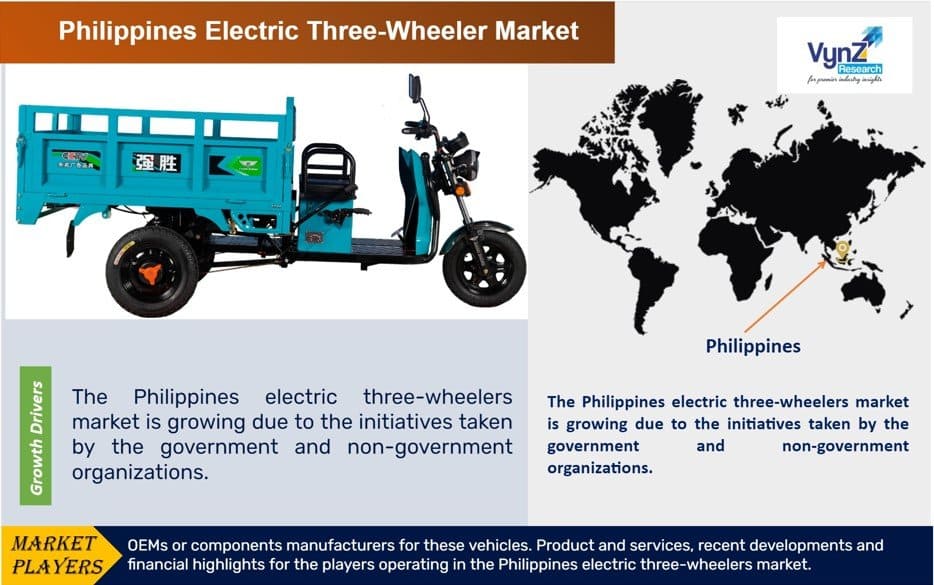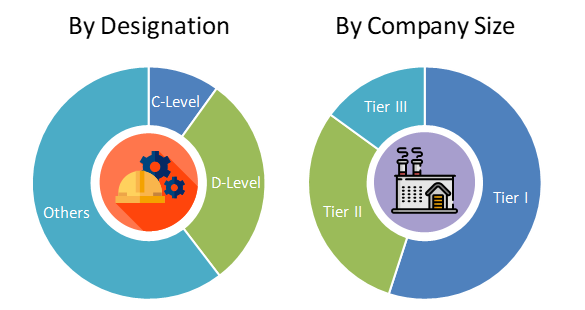| Status : Published | Published On : Nov, 2024 | Report Code : VRAT4059 | Industry : Automotive & Transportation | Available Format :

|
Page : 88 |
Philippines Electric Three-Wheeler Market Size & Share | Growth Forecast Report 2030
Industry Insights by Product (E-Rickshaw, E-Auto, Others) By Type (Passenger Vehicle, Load Carrier), by Motor Power (<1000 W, 1000-1500 W, >1500 W), by Driving Range (Less than 50 miles, 50-100 miles and Above 100 miles) and by Geography (Philippines)
Industry Overview
The Philippines Electric Three-Wheeler Market is predicted to grow at 10.8% CAGR during the forecast period, in terms of its fleet size.

The Philippines market is still unexplored with a few thousand units of electric three-wheelers on the road in the country in 2019; however, the market is anticipated to grow in the coming years due to the ongoing public-private initiatives and favorable government policies in place.
Philippines Electric Three-Wheeler Market Report Coverage
|
Report Metric |
Details |
|
Historical Period |
2020 - 2024 |
|
Base Year Considered |
2025 |
|
Forecast Period |
2026 - 2035 |
|
Market Size in 2025 |
U.S.D. XX Billion |
|
Revenue Forecast in 2035 |
U.S.D. XX Billion |
|
Growth Rate |
10.8% |
|
Segments Covered in the Report |
By Product, By Type, By Motor Power and By Driving Range |
|
Report Scope |
Market Trends, Drivers, and Restraints; Revenue Estimation and Forecast; Segmentation Analysis; Impact of COVID-19; Companies’ Strategic Developments; Market Share Analysis of Key Players; Company Profiling |
|
Regions Covered in the Report |
Philippines |
Philippines Electric Three-Wheeler Industry Dynamics
Philippines Electric Three-Wheeler Market Trends / Growth Drivers:
The Philippines electric three-wheelers market is growing due to the initiatives taken by the government and non-government organizations. The government in the Philippines is relying on public-private partnerships to develop and grow the electric vehicles industry in the country, which is directly supporting the growth of the electric three-wheeler market in the country. The Electric Vehicle Association of the Philippines (EVAP) has an optimistic view of the growth of electric vehicle sales in the Philippines owing to the support for these vehicles under Tax Reform for Acceleration and Inclusion (TRAIN) Law. Under the TRAIN Law, electric vehicles are exempted from higher excise tax, thus creating traction for investments to help sustain electric mobility in the country. The government is not only eyeing the expansion of electric vehicle sales in the major metropolitan cities but to the countryside. The government and non-government organizations are anticipating active participation from the local auto industry to flourish the electric vehicle industry in the country.
The Electric Vehicle Association of the Philippines (EVAP) plans for a national development program for electric vehicles that is anchored on the existing Motor Vehicle Development Program for the automotive industry. As per the association, this is to be implemented in four (4) phases within ten years. The Department of Energy in the Philippines is actively collaborating with the Department of Transport for the implementation of a Public Utility Vehicle modernization program that is aimed at transforming the Philippines’ public transport into a cleaner and more efficient mode of transportation. Such initiatives are expected to create a huge demand for electric three-wheelers in the country.
Philippines Electric Three-Wheeler Market Challenges:
The Philippines electric three-wheelers market is restrained due to various factors such as initial high cost of vehicles, limited charging infrastructure, lack of regulatory and policies issues.
Recent Developments by Key Players
BEMAC Corporation has acquired the shares in the Switch Engineering Oy, headquartered in Vaasa, Finland, hereinafter referred to as “The Switch” and its subsidiaries.
Piaggio Vehicles Pvt Ltd (PVPL) which is a 100 % Indian subsidiary of the Italian Piaggio Group and India’s leading manufacturer of small commercial vehicles as well as pioneers in 3-wheeler electric mobility entered their Apé Electrik vehicles in the Philippines. The electric 3-wheeler vehicles will be manufactured in PVPL’s plant in Baramati (Maharashtra) and exported to the Philippines. The company will be deploying the Apé E-City and Apé E-Xtra vehicles equipped with SUN Mobility’s advanced battery-swapping technology.
Philippines Electric Three-Wheeler Market Segmentation
VynZ Research provides an analysis of the key trends in each segment of the Philippines Electric Three Wheeler Market report, along with forecasts at the regional and country levels from 2025-2030. Our report has categorized the market based on product, type, motor power and driving range.
Insight by Product
- E-rickshaw
- E-auto
- Others
Based on product, the electric three-wheeler market is segmented into e-rickshaws, e-autos, and others. E-rickshaws are the most preferred three-wheeler category. E-rickshaws are the typical three-wheelers with a top speed of around 25km/hr. These are alternatives to conventional pull rickshaws with pedals and auto rickshaws. A typical e-rickshaw carries 4+1 or 3 passengers at a time.
Insight by Type
- Passenger Vehicle
- Load Carrier
Based on type, the market is categorized into passenger vehicles and load carriers. The Philippine's electric three-wheelers fleet size mainly constitutes passenger vehicles due to the increasing demand for a sustainable mode of intracity transport.
Insight by Motor Power
- <1000 W
- 1000-1500 W
- >1500 W
Based on motor power, the market is segmented into 1,500 W. Of all, 1,000-1,500 W powered three-wheelers hold the largest share in the Philippines market. The highest share of the 1,000-1,500 W powered three-wheelers in the market is due to the optimum performance and cost of the vehicle at this power.
Insight by Driving Range
- Less than 50 miles
- 50-100 miles
- Above 100 miles
The market is segmented based on driving range, as less than 50 miles, 50-100 miles and above 100 miles. The 50-100 miles segment dominated the market during the forecast period. Developments in electric vehicles with dynamic investments by automakers and increasing concerns about environmental pollution are the major factors for the growth of the market.
Philippines Electric Three-Wheeler Market: Geographic Overview
The National Capital Region (NCR) of Philippines has the most registered electric three wheelers.
Philippines Electric Three-Wheeler Market Competitive Insight
- Primegreen Power & Technology
- BEMAC Corporation
- WM Motor
- BYD
- Dongfeng Motor Corporation
The report offers competitive insight into the players offering electric three-wheelers, OEMs, or components manufacturers for these vehicles. Product and services, recent developments, and financial highlights for the players operating in the Philippines electric three-wheelers market.
BYD is the world leader in new energy vehicles with presence in over 70 countries. BYD has become a leading player in commercial vehicle solutions, electronics, renewable energy, and rail transit, with over 30 industrial parks across 6 continents.
Dongfeng Motor Corporation Ltd. is a Chinese state-owned automobile manufacturer headquartered in Wuhan, Hubei. Dongfeng main business covers commercial vehicles, passenger vehicles, NEVs, auto assemblies, parts and components, machines and equipment.
The Philippines Electric Three-wheeler Market report offers a comprehensive market segmentation analysis along with an estimation for the forecast period 2025–2030.
PRIMARY RESEARCH INTERVIEWS - BREAKDOWN

Frequently Asked Questions
Purchase Options
Latest Report
Research Methodology
- Desk Research / Pilot Interviews
- Build Market Size Model
- Research and Analysis
- Final Deliverabvle
Connect With Our Sales Team
- Toll-Free: 1 888 253 3960
- Phone: +91 9960 288 381
- Email: enquiry@vynzresearch.com
Philippines Electric Three-Wheeler Market
